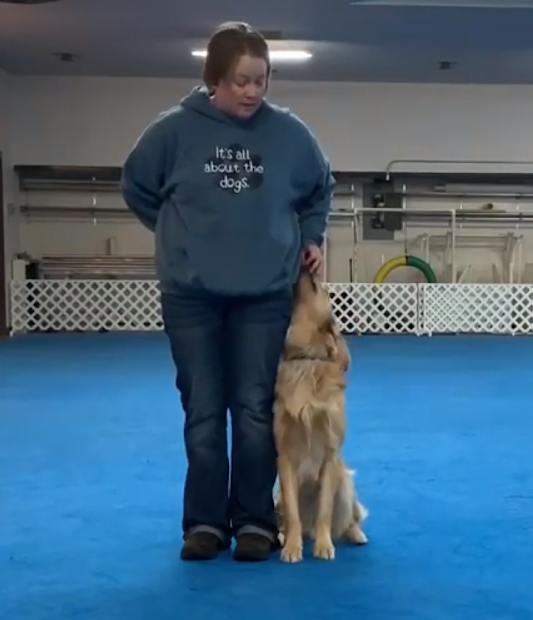Picture a training session. Your dog does the correct behavior, and you reward them. You did your job, right?
If your dog listened to your cue, and you gave the dog a treat, then all the important parts were taken care of... because marking and rewarding the behavior is the important part, right? Or is it?
Is your reward placement and delivery helping you... or hurting you?
Think about this scenario. You're working on halts with your dog. The treats are in your right hand so your dog doesn't mug your left hand for the treats. When the dog halts and sits, you mark and pass your treats from your right hand to your left hand in front of your body and feed.
A few weeks pass, and you notice your dog consistently sitting with his/her rear end out. What's going on? Because the treats have been coming from the front of your body, your dog is anticipating the reward coming from the front. That causes the dog to move towards the reward, which means the treat is usually delivered when the dog is slightly wrapping around you, causing the rear end to go wide. As you reward this behavior, it gets worse over time.
Dogs are very efficient creatures, and they will quickly figure out how to most effectively get the treat. Therefore, they tend to gravitate towards where the treat comes from. In the case of our halts example, this has caused a problem: the dog is sitting with his rear out.
But, we can also use this tendency to our advantage!
Take the above scenario of the dog sitting with the butt out. There are several ways we can try to change the dog's tendencies just by changing where the reward comes from. Different dogs will react different ways to changing the placement of reward.
However, sometimes it will cause the dog to do something else that we don't want to reinforce, so it's really important that you video the dog to see exactly what he or she is doing.
I had two students in my last set of classes with similar problems. In both cases, we gave changing reward placement a try.
The first student has a lovely Bernese Mountain Dog. The dog had a tendency to heel a bit wide, a bit forged, and often with his rear end out. So, we decided to try using reward placement to improve the dog's positioning.
One reward strategy that tends to work with dogs that have these habits is to reward behind your back. You pass the treat from your right hand behind your back to your left hand, and reward right in heel position.
Because this is easy to do and is often successful, I first suggested that she try rewarding from behind. As soon as I saw her next video, I could see that it wasn't working for this dog.
As the dog started to duck behind her to get the treat, his rear would go really wide and his heeling actually got worse. So, we abandoned that reward strategy and found another one that worked really well for him and improved his heeling dramatically. However, it's crucial that we stopped to evaluate how our plan was working; otherwise, our situation may have actually continued to get worse!
The second student in that class owned a lovely Australian shepherd named Tilly.
Case Study: Changing reward placement to improve Tilly's heel
Tilly is a very enthusiastic worker. Tilly's tendencies in heeling are to forge and to sit with her rear end out. Again, we choose to try a different reward placement to see if that would help improve her heeling. I'd like to show you a couple of short videos so you can see just how much of a difference reward placement can make.
Here's one of the first heeling videos I saw of her.
I absolutely love Tilly's attention to her mom during this heeling, but immediately noticed how forged she was, and how she halted crooked. When I saw this video, I suggested that Tilly's mom start rewarding from behind her back, by passing the treat from the right hand behind her back to her left and feeding in heel position. They worked on this skill for a few weeks and this was the final heeling video that they posted.
Look what a difference there was! And the only thing she changed was reward placement.
It's crazy that such a simple easy thing can help so much!
Other applications: Where else should we consider our reward placement?
I use reward placement in tons of obedience behaviors. I have several different marker words that I teach my dogs so that I can reward them in different ways, depending on the behaviors that I'm working and the tendency of the dog. Sometimes, particularly with heeling, I'll use multiple reward strategies in the same training session!
My upcoming workshop, It's All About the Rewards! Using Placement of Reward to Your Advantage, goes over all the types of obedience behaviors and the different reward strategies you can use. We go over stays, signals, recalls, drop on recalls, station behaviors, heeling, go outs, moving stands, and more. I give you different options that you can use with each type of behavior, and provide lots of video examples. If you are looking to improve the accuracy of your dog's behaviors without a lot of effort and training, be sure to check out this workshop!
